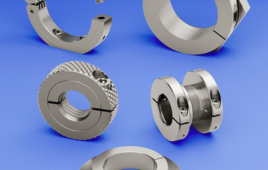Bellows couplings consist of 2 basic elements—stainless steel bellows and two hubs. The hubs are usually made of steel, stainless steel or aluminum. Manufacturers often add a coating of zinc or nickel plating or other hardening finishes to protect the surfaces of the hubs.
Perhaps the most important aspect of making a bellows coupling, is constructing the bellows portion itself. The process begins with a tube of steel placed into a die. A hydroforming press then pressurizes water inside the tube and creates corrugations along the length of the tube.
Once the tube has been corrugated into a bellows the two coupling hubs are attached. There are a few methods to connect the three components including welding, crimping, bonding and others.
The compression inherent to the crimping process can sometimes compromise the structure of the coupling— yet, the process is still used. Similarly, the high temperatures involved with welding have the potential to warp the finished coupling as well. Lastly, the bonding method uses an adhesive to attach the hubs to the bellows and offers a high degree of precision.
![]()
Filed Under: Bellows, Coupling Tips




